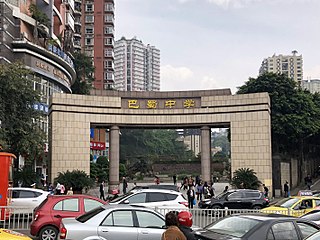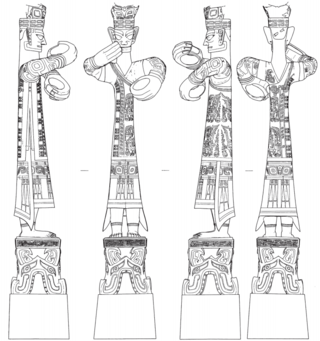
Sichuan is a province in Southwestern China occupying the Sichuan Basin and Tibetan Plateau between the Jinsha River on the west, the Daba Mountains in the north and the Yungui Plateau to the south. Sichuan's capital city is Chengdu; its population stands at 83 million. Sichuan neighbors Qinghai to the northwest, Gansu to the north, Shaanxi to the northeast, Chongqing to the east, Guizhou to the southeast, Yunnan to the south, and Tibet to the west.

Chengdu is the capital city of the Chinese province of Sichuan. With a population of 20,937,757 at the 2020 Census, it is the fourth most populous city in China, and it is the only city with a population of over 20 million apart from direct-administered municipalities. It is traditionally the hub of Western China.

Sanxingdui is an archaeological site and a major Bronze Age culture in modern Guanghan, Sichuan, China. Largely discovered in 1986, following a preliminary finding in 1927, archaeologists excavated artifacts that radiocarbon dating placed in the twelfth–eleventh centuries BC. The archaeological site is the type site for the Sanxingdui culture that produced these artifacts, archeologists have identified the locale with the ancient kingdom of Shu. The artifacts are displayed in the Sanxingdui Museum located near the city of Guanghan.

The Sichuan Basin, formerly transliterated as the Szechwan Basin, sometimes called the Red Basin, is a lowland region in southwestern China. It is surrounded by mountains on all sides and is drained by the upper Yangtze River and its tributaries. The basin is anchored by Chengdu, the capital of Sichuan province, in the west, and the direct-administered municipality of Chongqing in the east. Due to its relative flatness and fertile soils, it is able to support a population of more than 100 million. In addition to being a dominant geographical feature of the region, the Sichuan Basin also constitutes a cultural sphere that is distinguished by its own unique customs, cuisine and dialects. It is famous for its rice cultivation and is often considered the breadbasket of China. In the 21st century its industrial base is expanding with growth in the high-tech, aerospace, and petroleum industries.

Nanchong is a prefecture-level city in the northeast of Sichuan province, China, with an area of 12,479.96 km2 (4,818.54 sq mi). At the 2020 census it was home to 5,607,565 people, of whom 1,936,534 lived in the built-up area made of three urban districts. It is the second most populated city of Sichuan Province, after Chengdu. The administrative center is Shunqing District.

Jinsha is a Chinese archaeological site located in the Qingyang District of Chengdu, the capital of China's Sichuan Province. Along with Sanxingdui, the site is the first major discovery in China during the 21st century. It is listed on the UNESCO World Cultural Heritage Tentative List and Major Sites Protected at the National Level. The Chinese Internet Information Centre ranked Jinsha 5th on the Top 10 Archaeological Discoveries in 2001.

Ba was an ancient state in eastern Sichuan, China. Its original capital was Yicheng, Hubei. Ba was conquered by Qin in 316 BC. The historical Bo people and the modern Tujia people trace some of their origins back to the people of Ba.

Shu (Chinese: 蜀; Sichuanese Pinyin: Su2; former romanization: Shuh), also known as Ancient Shu (Chinese: 古蜀) in historiography, was an ancient kingdom in what is now Sichuan Province. It was based on the Chengdu Plain, in the western Sichuan basin with some extension northeast to the upper Han River valley. To the east was the Ba tribal confederation. Further east down the Han and Yangtze rivers was the State of Chu. To the north over the Qinling Mountains was the State of Qin. To the west and south were tribal peoples of little military power.

Sichuanese or Szechwanese (simplified Chinese: 四川话; traditional Chinese: 四川話; Sichuanese Pinyin: Si4cuan1hua4; pinyin: Sìchuānhuà; Wade–Giles: Szŭ4-ch'uan1-hua4), also called Sichuanese/Szechwanese Mandarin (simplified Chinese: 四川官话; traditional Chinese: 四川官話; pinyin: Sìchuān Guānhuà), is a branch of Southwestern Mandarin spoken mainly in Sichuan and Chongqing, which was part of Sichuan Province until 1997, and the adjacent regions of their neighboring provinces, such as Hubei, Guizhou, Yunnan, Hunan and Shaanxi. Although "Sichuanese" is often synonymous with the Chengdu-Chongqing dialect, there is still a great amount of diversity among the Sichuanese dialects, some of which are mutually unintelligible with each other. In addition, because Sichuanese is the lingua franca in Sichuan, Chongqing and part of Tibet, it is also used by many Tibetan, Yi, Qiang and other ethnic minority groups as a second language.

The Minjiang dialect is a branch of Sichuanese, spoken mainly in the Min River (Mínjiāng) valley or along the Yangtze in the southern and western parts of the Sichuan Basin in China. There is also a language island of the Minjiang dialect located in the center of the Sichuan Basin covering several counties, including all of Xichong, Yanting, and Shehong Counties, and part of Jiange, Cangxi, Nanbu, Langzhong and Bazhong. The Minjiang dialect is also referred to as the Nanlu dialect by some scholars.
Ba–Shu Chinese (Chinese: 巴蜀語; pinyin: Bāshǔyǔ; Wade–Giles: Ba1 Shu3 Yü3; Sichuanese Pinyin: Ba¹su²yu³; IPA:[pa˥su˨˩y˥˧]), or simply Shu Chinese (Chinese: 蜀語), also known as Old Sichuanese, is an extinct Chinese language formerly spoken in what is now Sichuan and Chongqing, China.

The Sichuanese people are a Han Chinese subgroup comprising most of the population of China's Sichuan province and the Chongqing municipality.

Chengdu-Chongqing dialect or Cheng–Yu is the most widely used branch of Southwestern Mandarin, with about 90 million speakers. It is named after Chengdu, the capital city of Sichuan, and Chongqing, which was split from Sichuan in 1997. It is spoken mainly in northern and eastern Sichuan, the northeastern part of the Chengdu Plain, several cities or counties in southwestern Sichuan, southern Shaanxi and western Hubei.

Jinli is a street in Chengdu, Sichuan, China. Its history can be traced back to the pre-Qin Dynasty era more than 1800 years ago. Jinli was ranked first in "the world's most beautiful streets" published by CNN Travel in 2019.

Chongqing Bashu High School is ranked 5th in China and 2nd in Chongqing High School Ranking. No. 5 in China for seven consecutive years.)

The Venerable Vyvyan Henry Donnithorne, MC, MA was Archdeacon of Western Szechwan from 1935 to 1949.
The joint tombs of boat-shaped coffins are tombs of the ancient kingdom of Shu discovered in Chengdu, Sichuan, China, coinciding with the Spring and Autumn period (770–476 BC) and the Warring States period (476–221 BC). and apparently also occurred during the Qin dynasty (221–206BC).
Gospel Church is a Protestant church situated on Dabei Upper Street, in the county-level city of Guanghan, Deyang, Sichuan Province. Founded in 1902, it was formerly an Anglican church in the West Szechwan Diocese of the Church in China. It has been subjected to the control of the state-sanctioned Three-Self Patriotic Church since 1954. In 2003, a new church was built on Shuyuan Street, and renamed Grace Church.

Islam is a minority religion in the Chinese province of Sichuan. The total number of Muslims are 112,478 according to a 2004 census conducted by the Islamic Association of China, the majority are ethnic Hui. Chengdu, the provincial capital, and Xichang, capital of the Liangshan Yi Autonomous Prefecture, are the two cities with high concentration and long history of the Hui communities. According to a 1990 census, 23,288 Muslims resided in Ngawa Tibetan and Qiang Autonomous Prefecture of western Sichuan, with about 40 mosques catering to their religious needs. Counties with highest number of Muslims in this region are Ma'o, Ngawa, Quqên, Sirza Degu, Sungqu, Tsanlha, and Zoigê.

Clothing in ancient Shu refers to clothing worn in the Ancient Kingdom of Shu. Archaeological finds in Sanxingdui and Jinsha sites have provided the best source of information on ancient Shu costume. Shu clothing's right over left lapel closing was considered "very strange" by Yang Xiong, a 1st-century BC author from Pi County, Chengdu, as in contrast to contemporary Chinese Western Han clothing's left over right lapel closing.






























